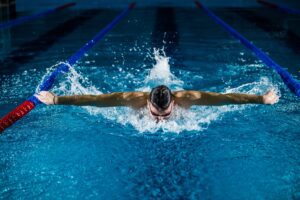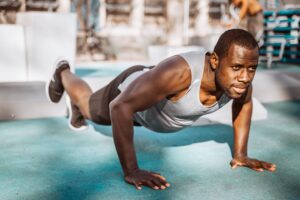Swimming, a sport that demands strength, endurance, and impeccable technique, places a substantial emphasis on the upper body. While time spent in the water is crucial for a swimmer’s development, dryland exercises play a complementary role in building the strength necessary for peak performance. Among these exercises, push-ups stand out as a versatile and effective means of enhancing upper body strength – a vital component for swimmers striving to glide through the water with efficiency and speed.
The Importance of Upper Body Strength for Swimmers
Swimmers rely heavily on their upper body muscles to propel themselves through the water. A robust upper body not only contributes to powerful strokes but also plays a crucial role in maintaining proper body position, reducing drag, and improving overall swimming efficiency. The muscles engaged in swimming, particularly the chest, shoulders, and triceps, are primary targets of push-ups, making this exercise a valuable addition to a swimmer’s dryland training regimen.
Benefits of Push-Ups for Swimmers
- Chest Strength: The chest muscles, essential for an effective pull during strokes, are heavily engaged in push-ups. Building chest strength enhances a swimmer’s ability to execute powerful and controlled arm movements.
- Shoulder Stability: The repetitive nature of swimming strokes can place strain on the shoulders. Push-ups, with their focus on the deltoids, contribute to shoulder stability, reducing the risk of injuries and promoting a smoother swim technique.
- Tricep Endurance: The triceps play a pivotal role in the extension of the arms during the underwater phase of swimming strokes. Push-ups target the triceps, aiding in the development of endurance crucial for sustained and powerful arm movements.
- Core Activation: A strong core is fundamental for maintaining body position and stability in the water. Push-ups engage the core muscles, enhancing overall core strength and aiding swimmers in achieving streamlined body positioning.
- Improved Breathing Mechanics: The coordinated movements of push-ups, involving controlled inhalation and exhalation, can contribute to improved breathing mechanics – a critical aspect of swimming performance.
Push-Up Variations Tailored for Swimmers
- Standard Push-Up:
- Focus: Overall upper body strength.
- Technique: Maintain a straight line from head to heels, engaging the chest, shoulders, and triceps.
- Wide-Grip Push-Up:
- Focus: Chest and outer shoulders.
- Technique: Position hands wider than shoulder-width apart to target the outer chest and shoulders.
- Close-Grip Push-Up:
- Focus: Triceps and inner chest.
- Technique: Place hands closer together to emphasise the triceps and inner chest.
- Incline Push-Up:
- Focus: Upper chest and shoulders.
- Technique: Elevate hands on a bench or surface, targeting the upper chest and shoulders.
- Decline Push-Up:
- Focus: Lower chest and triceps.
- Technique: Elevate feet on a sturdy surface, engaging the lower chest and triceps.
- One-Arm Push-Up:
- Focus: Core stability, chest, and triceps.
- Technique: Perform a push-up while balancing on one arm, challenging both upper body and core muscles.
Incorporating Push-Ups into a Swimmer’s Training Plan
- Warm-Up Routine:
- Begin your dryland session with a dynamic warm-up to prepare your muscles for the upcoming workout.
- Include light cardio, dynamic stretches, and bodyweight exercises to increase blood flow and joint mobility.
- Push-Up Circuit:
- Create a push-up circuit that incorporates variations targeting different muscle groups.
- Example Circuit: Standard Push-Ups (1 minute) > Wide-Grip Push-Ups (1 minute) > Incline Push-Ups (1 minute) > Repeat for 3 sets.
- Strength and Endurance Training:
- Combine push-ups with other strength and endurance exercises to create a well-rounded workout.
- Include exercises such as pull-ups, dips, and bodyweight squats to engage various muscle groups.
- Consistency is Key:
- Integrate push-ups into your dryland routine consistently, aiming for at least two to three sessions per week.
- Track your progress and gradually increase the intensity by adding more challenging variations or increasing the number of repetitions.
- Recovery and Flexibility:
- Include post-workout stretches to enhance flexibility and aid in muscle recovery.
- Focus on stretching the chest, shoulders, and triceps to maintain optimal range of motion.
Additional Tips for Swimmers Incorporating Push-Ups:
- Mindful Breathing:
- Coordinate your breath with each push-up, focusing on controlled inhalation and exhalation. This mirrors the controlled breathing required in swimming.
- Maintain Form:
- Prioritise proper form over quantity. A controlled and well-executed push-up is more beneficial than rushed repetitions with compromised form.
- Rest and Recovery:
- Allow adequate time for rest and recovery between sessions. This is essential for preventing overuse injuries and ensuring optimal performance in the pool.
- Consult with a Professional:
- If you’re new to dryland training or have specific fitness goals, consider consulting with a fitness professional to tailor a training plan that aligns with your swimming objectives.
Conclusion:
Push-ups, with their ability to target key upper body muscles, are a valuable asset in a swimmer’s dryland training toolkit. By incorporating push-ups into a consistent and well-rounded training routine, swimmers can enhance their upper body strength, improve muscle endurance, and contribute to overall swimming performance. As you feel the burn in your chest and triceps during a set of push-ups, remember that you’re not just building physical strength – you’re refining the power that propels you through the water with every stroke.



